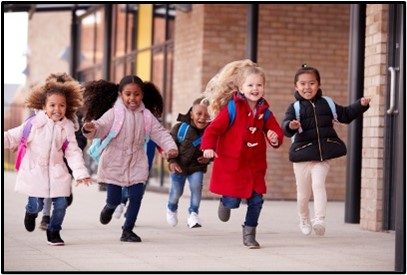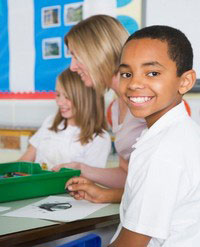Creating a Safe Classroom to Foster Social and Emotional Skills

The first step in fostering an environment where students’ social and emotional skills are developed is creating a safe classroom environment. This blog article shows you how to accomplish that goal.
All students have the legal right to attend a school in which they feel safe. The Safe and Drug-Free Schools and Communities Act (SDFSCA) was signed into law on January 8, 2002. This piece of legislation has four overreaching goals — (1) to prevent violence in schools; (2) to prevent use of illegal substances; (3) to involve parents and community members; and (4) to create safe and drug-free learning environments that help students achieve academically. As you can see, the SDFSCA works to ensure that students feel safe while at school.
The good news is that most young students already view school as a safe place. For the most part, they are excited to come to school. They love their teachers and look forward to learning and playing with their friends. Sadly, the same cannot be said for students in grades 5-12. According to youthtruthsurvey.org, only 66 percent of students feel safe in their classes. Students can’t learn if they don’t feel safe. And herein lies the conundrum. How can teachers make their students feel safe in the classroom?
Creating a Safe Space
The sad truth is that despite our vigilance, we don’t always know what happens when our students leave our classroom. While Billy might appear to be well taken care of — clean clothes, well fed, no apparent bruises — what you don’t see is what is waiting for him at home — the drunken rants, his parents’ impending divorce, or the all-around emotional pain that he carries with him wherever he goes. And while Billy may put on a good face while he is in your care, we can’t always know the challenges that he faces, often daily. It is for this reason that we, as teachers, must make sure that our classrooms are a welcome shelter from the storm.
The following are some general suggestions of what you can do to make your classroom a safe haven for the Billys of the world (Linsin, 2011).
- Maintain consistency and predictability. Do you have a favorite exercise class instructor, so much so that you may walk out of a class if there is a substitute? Or perhaps you will only buy Charmin® over any other toilet paper brand? Why do you suppose this is so? It’s because these things are consistent and predictable, which makes them reliable and dependable. You implicitly trust your instructor to give you the best workout, just as you trust Charmin® to do its job better than the competition. You just know that this person or that product won’t fail you. Well, students are the same. They want a teacher who is predictable, reliable, and consistent because they trust that person to do the job correctly.
Believe it or not, students relish routine. They are most comfortable when they know what is expected of them throughout the school day. Routines give a sense of normalcy to students who might otherwise lack this at home. It allows them to let down their guard just long enough to get lost in the process of learning, and a well-run classroom is just the vehicle to make this happen. As much as possible, be sure to stick to a predictable daily schedule and let students know in advance when and if it might get interrupted (e.g., school assemblies, guest speakers, etc.). Furthermore, well-taught and practiced routines and procedures go a long way toward not only improving classroom management, but they help to make students feel safe, largely because students know what to do and what is expected of them and others.
- Establish an atmosphere of trust. People who are trustworthy are honest, loyal, and reliable. According to its definition, a person who has proven him/herself to be trustworthy does what s/he says s/he will do. We can often discern that people are trustworthy when they meet their responsibilities. Students in the early elementary grades generally do not have an issue with trust, but unfortunately the same cannot be said for older students, or students in general who have experienced trauma. For students like Billy, they are quick to assume the worst because someone close to them has let them down in the past. The following are some suggestions of what you can do as a classroom teacher to build a trusting classroom environment.
- Be yourself. No one likes a phony, and students as young as preschool are quite adept at spotting one. For example, don’t pretend that you’re an amazing singer if you can’t carry a tune. Students will spot the discrepancy right away and the element of trust begins to chip away. Don’t pretend to be something you’re not. Instead, be you.
- Be honest. Everyone makes mistakes — you know it, students know it, everyone knows it. No one is perfect so when (not if) you blunder, admit it humbly and honestly. “Gee, boys and girls, I really need to apologize to all of you. For a moment I thought we had already covered the long a sound, but in fact we only learned about the short sound. This must be why many of you are having a hard time understanding what I’m talking about.” Or, with older students, you may have to admit that you didn’t correctly upload the latest study guide to your website or school’s learning management system. An “I’m sorry” goes a long way in terms of trust.
- Be reliable. If you make a promise, follow through. To you, it may not seem like a big deal that the pizza party you promised happens Thursday instead of Tuesday, but to students whose social and emotional radar is on high alert, it can be the difference between trust and skepticism. If something comes up to delay it, make sure that students know ahead of time.
- Be fair. Your policies and procedures should be followed accordingly, no matter who the student is. The consequence and/or action needs to be consistent from person-to-person and from incident-to-incident. For example, if your policy is to give a warning before flipping a behavior card or giving a detention, make sure that you follow through in the same manner for each and every student. Rest assured that the class notices when you consistently give a pass to a student or two. This isn’t fair, and students will call you out on it. Actions like this ultimately lead to the dissolution of trust.
- Create consistent procedures. As already mentioned, the establishment of effective procedures goes a long way to establishing trust and thus a safe classroom space. The repetition of acts and tasks (procedures) creates consistency which in turn, lets students “in on the secret.” If students know beforehand what to expect and how to perform certain classroom procedures, there is less room for error. From bell to bell, knowing what to expect and how to perform the classroom procedures makes tasks easier.
- Remain current and competent. Teacher credibility refers to a teacher’s ability to present him/herself as a person with something to offer students in terms of knowledge, insight, and experience. To maintain this credibility, teachers need to, whenever possible, seek out professional development opportunities. These new strategies and technologies can assist teachers in reaching all their students — whether they are gifted, have special needs, are English language learners, are suffering from trauma, or just “regular” students. Be sure to stay current with the various teaching journals and with the content you teach. Students tend to put their trust in you if you come to class prepared each and every day.
- Be kind. While this may seem so simple, it means so much, especially to students whose social and emotional skills have not fully developed. Treat every student with kindness, patience, and gentleness, regardless of how difficult a day it may be or what obstacles you are up against. Doing this one simple act will send your likeability score through the roof, thus helping students to build rapport not only with you, the teacher, but also with their peers. Be a role model.
- Protect and advocate for your students. Young children are still learning how to stand up for themselves and for them to feel welcomed and safe, they need to know that someone else has their back. Same for older students, who after years of schooling, may feel socially isolated by students or beaten down by the institution. They need to know that they have a clean slate with you. You need to work hard every day to ensure that students feel confident in knowing that they will be able to enjoy their day without fear of being teased, picked on, or bullied, either physically or mentally.
- Don’t take misbehavior personally. Young students often do not have the necessary social and emotional tools to express themselves properly. So, when they get upset or frustrated, there is bound to be some inappropriate push back, from an adult’s perspective anyway. Older students, on the other hand, often intentionally push back. So, when (not if) this happens, don’t take it personally. The push back is not a reflection on you. Instead, acknowledge their feelings and work together to come up with a plan to ease the burden.
- Maintain a peaceful learning environment. You would be hard-pressed to find anyone who performs well in a tension-filled environment. This is especially true for students of trauma and for those whose social and emotional skills have not yet matured. When confronted with tension and obstacles to learning, these students often shut down, stare off into space, or engage in some serious misbehavior. A classroom is only as peaceful as the teacher in charge. So, be sure to set the tone with your calm presence and pleasant attitude, even in the face of trying circumstances.
Activities That Inspire SEL Skills
The outcomes of a successful SEL program include positive social behaviors and better relationships with both peers and adults, as well as improved test scores, increased attendance, and better grades, all of which contribute to less risk-taking behavior and reduced behavior problems (Sklad et al., 2012). In the short term, attending to students’ social and emotional needs — whether students have experienced childhood trauma or not — makes for happier, more well-adjusted individuals. In the long term, an increase in social and emotional competence and emotional intelligence is bound to affect such school-related factors as an increase in the graduation rate and a readiness for college and career opportunities. This, in turn, leads to better overall mental health, positive family and work relationships, less criminal behavior, and an increase in citizenship-type behaviors (Jones, Greenberg, & Crowley, 2015). The following activities can be used to incorporate some best practices to help students deal with social and emotional issues.
- Incorporate mindfulness exercises. Mindfulness is the basic human ability to be fully present, aware of where we are and what we’re doing, and not overly reactive or overwhelmed by what’s going on around us. The reduction of stress is possibly the most often-cited benefit of mindfulness, which is why it is such an important tool to have in your arsenal, especially for those students whose social-emotional skills are taxed. The purpose of mindfulness is to engage students in the here-and-now. Students need to be able to sort through all the extraneous information in order to attend to the present. To introduce students to the concept of mindfulness, try any of the following activities.
- Use Your Spidey Senses. Like Spiderman, students can also use their special senses to focus on the present. Simply have them “turn off” one of their senses at a time. For example, have students close their eyes and listen to the sounds around them. What do they hear? The clock ticking? The teacher next door? Somebody’s tummy rumbling? As students work through this classic mindfulness exercise, they quickly learn that by concentrating on the present and cutting out any extraneous information, their super-focused senses can be used to keep tabs on the world around them, causing them to become more self-aware.
- Name that emotion. Once a classroom environment that is built on trust and mutual respect has been established, this activity is really easy to do. Simply have each student call out the emotion s/he is feeling as s/he enters the room. This helps students understand not only how they may be feeling, but how their peers are feeling as well. This provides a basis for helping students determine the best way to interact with their peers based on their emotions. For example, if Josh says he’s sad, knowing Josh’s emotion ahead of time helps his lab partner treat him with kindness and empathy.
- Stress: Write it down, rip it up, and throw it away. This emotional check-in takes a total of approximately three minutes. It works like this. Simply have students write down their emotions, insecurities, and negative expectations and/or experiences on a piece of paper. Then, have them rip them up and toss them in the garbage. For example, Olivia might be feeling frustrated because she stayed up late the night before working on a paper, only to have her computer crash half-way through the project. This acknowledges Olivia’s (and every student’s) feelings while at the same time it also re-directs them to the present. It also signals that as their teacher, you realize that each and every student has a barrier to learning, but you are willing to work with them to help them overcome any difficulty.
- Practice yoga. Yoga in schools is becoming increasingly popular, and with good reason. The research points to the fact that the practice of yoga in schools, when coupled with mindfulness practices, addresses the whole student. In fact, the practice of yoga in schools has been proven to not only increase students’ emotional intelligence, but it also helps students develop social competency, increases their ability to focus, teaches them adaptable coping strategies, and contributes to their overall positive and compassionate attitudes (Butzer, Telles, & Khalsa, 2016; Maynard, et al., 2017). Click on any of the links below if you would like to learn more and check out additional resources in relation to teaching yoga in the classroom.
- Create an inviting safe space where students can go to destress. Students can get frustrated easily, whether the cause of their stress is school-related or not. The reason this happens is that they have not yet learned how to properly regulate their emotions and respond to conflict in a healthful way. So, when a stress-inducing incident occurs (whether it occurs inside or outside of the classroom), a student may begin to feel overwhelmed and as a result, s/he may begin to shut down or respond in a negative manner. In instances such as these, it is important to have an inviting safe space where they can go to destress. Try to make the space as comfortable and homey as possible. Include a comfortable chair, some stuffed animal “friends” for younger students, calming books, and perhaps even a mindfulness jar. A mindfulness jar is designed to teach students how emotions can swirl up unexpectedly and take hold of their actions. Mindfulness helps students to calm those swirling emotions, making their path easier to navigate.
- Design a plan for the expression of feelings or problems at home or at school. As much as teachers want to help and don’t want to see their students suffer, the fact is that sometimes a professional needs to be called in. If you begin to feel overwhelmed on how to help your students express their feelings or problems — either at home or at school — be sure to talk to your school counselor, social worker, or psychologist. Put together a plan of action so that both you and your students know what to do, should it ever come to this.
|
Materials:
|
Procedure:
|
Safe Learning Environment Check In
In what ways do you contribute to creating a safe learning environment for your students? Answer the questions below.
- Do you often ask your students how they are doing?
- Do you keep your classroom door open during breaks?
- Do you find time to meet with students one-on-one about concerns?
- Would your students identify you as a happy person?
- Do you find ways to reward students for their good work?
- Do you feel comfortable intervening in student conflicts?
- Is laughter abundant in your classroom?
- Are students often in a good mood in your class?
- Are you essentially the same person in the classroom as you are outside of the classroom?
- Do you develop many activities that allow students to be creative and display their uniqueness?
If you answered yes to seven or more of these questions, congratulations! You are already on a great path to establishing a safe classroom environment. If you answered yes to six or fewer questions, there is work to be done.
Are you curious? Want to learn more?
To learn more about social and emotional learning, visit the Professional Development Institute (PDI) website or go directly to comprehensive list of courses for Social and Emotional Learning training. The Professional Development Institute has been offering quality online professional development courses to K-12 educators for over 27 years and provided training to over 345,000 teachers across the globe. We specialize in offering quality, affordable university-approved online courses that focus on the most relevant topics in education while providing practical strategies that can be implemented in the classroom immediately. All PDI courses are at the graduate-level, instructor-led, and are conducted entirely online. University credit is available through University of California Division of Extended Studies. PDI offers an extensive catalog of online courses for teachers on topics that are the most critical in today’s classrooms.
Article References
Butzer, D.B., S. Telles, S.S. Khalsa (2016). “Implementing yoga within the school curriculum: A scientific rationale for improving social-emotional learning and positive student outcomes.” In Journal of Children’s Services, 11(1), pgs. 3-24.
Jones, D.E. M. Greenberg, & M. Crowley (2015b). “Early social-emotional functioning and public health: The relationship between kindergarten social competence and future wellness.” Retrieved 13 Nov. 2017 from http://ajph.aphapublications.org/doi/abs/10.2105/AJPH.2015.302630
Linsin, M. (2012). “Classroom Management and the Power of Your Personality.” Retrieved 15 June 2017 from https://www.smartclassroommanagement.com/2012/04/21/classroom-management-and-the-power-of-your-personality/
Maynard, B.R., M.R. Solis, V.L. Miller, K.E. Brendel (2017). “Mindfulness-based interventions for improving cognition, academic achievement, behavior, and socioemotional functioning of primary and secondary school students.” Retrieved 14 Dec. 2017 from https://campbellcollaboration.org/media/k2/attachments/Campbell_systematic_review_-_Mindfulness_and_school_students.pdf
Sklad, M., R. Diekstra, M. De Ritter, J. Ben, & C. Gravesteijn (2012). “Effectiveness of school-based universal social, emotional, and behavioral programs: Do they enhance students' development in the area of skill, behavior, and adjustment?” Retrieved 13 Nov. 2017 from http://onlinelibrary.wiley.com/doi/10.1002/pits.21641/abstract
Categories: SEL, social and emotional learning

View PDI's Catalog of Courses
Check out a list of all PDI graduate-level online courses or sort by grade level or subject area.

Register Now!
Quick access to register for PDI's online courses using our secure system.

Learn More about PDI
Find out how to reach PDI and get answers to any questions you may have.

